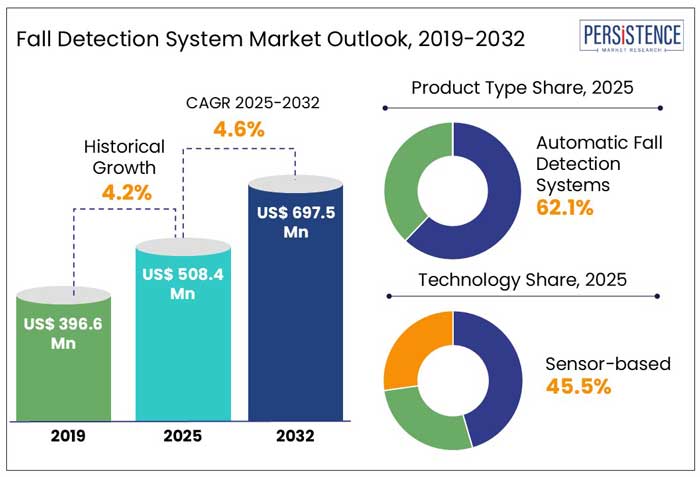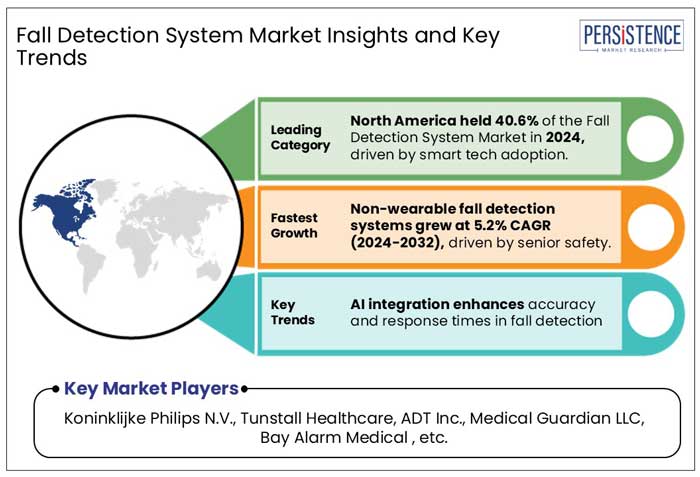Industry: IT and Telecommunication
Published Date: March-2025
Format: PPT*, PDF, EXCEL
Delivery Timelines: Contact Sales
Number of Pages: 157
Report ID: PMRREP8878
The Global fall detection system market value is projected to reach US$ 697.5 million by the year 2032 from US$ 508.4 million in 2025 growing at a steady CAGR of 4.6%. The increasing incidence of chronic conditions such as Alzheimer's and Dementia has increased the danger of falling, particularly among the elderly. The fall detection system is specially designed for the elderly population.
If a fall detection system detects an accidental fall, it will notify emergency services. The system is made up of two key parts: a wearable gadget and a smartphones. When the wearable gadget detects a fall, it sends an alarm to the mobile phone, which subsequently informs the user's emergency contacts. Some of the negative repercussions of a fall can be mitigated using fall detection systems.

|
Attribute |
Key Insights |
|
Fall Detection System Market Size (2025E) |
US$ 508.4 Mn |
|
Market Value Forecast (2032F) |
US$ 697.5 Mn |
|
Projected Growth (CAGR 2025-2032) |
4.6% |
|
Historical Market Growth (CAGR 2019 to 2024) |
4.2% |
The fall detection system market has experienced steady growth, with a historical (CAGR) of 4.2% from 2019 to 2024. This is mostly due to reasons such as consumers’ uptake of wearable technologies. Apart from that, increased smartphone usage is projected to fuel the market.
Furthermore, the rising consumers’ preference for personal healthcare systems also boost the global fall detection system market. With a forecasted CAGR of 4.6% from 2025 to 2032, technological developments and the integration of AI technology are expected to fuel market growth in the coming years, creating significant expansion opportunities.
Patient-oriented fall detection systems are designed to enhance safety by enabling prompt intervention during emergencies. These systems utilize advanced technologies such as motion sensors, accelerometers, and AI-driven analytics to detect falls with high precision. Wearable devices, smart home integration, and remote monitoring solutions ensure continuous supervision without compromising user comfort.
By providing instant alerts to caregivers or healthcare professionals, these systems help mitigate risks and improve response times. Their role extends beyond detection, offering predictive insights that aid in fall prevention strategies. As healthcare solutions become more personalized, these systems support independent living while ensuring timely medical assistance.
Increasing adoption of smartphones and other mobile devices created an ideal setting for the growth of fall detection systems. Numerous software apps can be installed on smartphones, allowing them to operate as low-cost fall detection systems. Smartphones provide a realistic and simple method of implementing fall detection systems.
Since smartphone based fall detection systems become popular among end-users, researchers are working to overcome tiny flaws that impair some system accuracy. The increasing penetration of smartphones and the integration of fall detection systems into software applications are likely to provide huge growth prospects for the market.
Technological advancements in the fall detection systems are revolutionizing elderly care and workplace safety. Innovations include AI-powered sensors, wearable devices, and radar-based monitoring for enhanced accuracy. Machine learning algorithms improve fall prediction, reducing false alarms. Integration with IoT enables real-time alerts to caregivers via smartphones and smart home systems.
Edge computing enhances speed and efficiency, minimizing reliance on cloud processing. Additionally, computer vision and LiDAR technology provide non-intrusive monitoring solutions. These advancements drive market growth by improving reliability and expanding applications in healthcare, assisted living, and occupational safety, ensuring better protection for vulnerable individuals and workers.
The high cost of fall detection systems is likely to impede the market's growth. High subscription fees hinder these devices from being used in underdeveloped economies. Furthermore, some fall detection systems available in the market are not completely reliable and can harm market growth.
According to the U.S. Centers for Disease Control and Prevention, falls among adults 65 and older caused over 38,000 deaths in 2021, making it the leading cause of injury-related death for that age group. In the same year, emergency departments recorded nearly 3 million visits for older adult falls, highlighting the urgent need for effective fall detection and prevention solutions.
Despite the fact that the rate of falls globally is increasing, lack of awareness regarding the fall detection system is hampering market growth, particularly in developing countries. Additionally, a lack of knowledge and technology in some economically backward countries is a major restraint for the market.
In regions such as South Asia, Africa, and parts of Latin America, the lack of education on elderly care technology, lower disposable income, and inadequate healthcare infrastructure contribute to low adoption rates. A 2023 WHO report highlighted that over 80% of fatal falls occur in low- and middle-income countries, yet awareness of fall detection solutions remains significantly lower than in developed regions.
The North America market dominated the global market with a share of approximately 40.9% in 2024 and is expected to exhibit significant growth in the coming years, due to its advanced healthcare infrastructure, and high awareness of personal safety. The region has a growing elderly population with mobility challenges and is boosting demand for smart assistive devices and home modifications. Strong healthcare expenditure and favorable reimbursement policies further support market growth.
Technological advancements, including AI-based and wearable fall detection devices, enhance adoption.
Companies like Philips Lifeline, Apple (Apple Watch Fall Detection), and Medical Guardian are experiencing high adoption of their smart fall detection systems, particularly among seniors and caregivers. The growing integration of these technologies in assisted living facilities further strengthens North America's market.
The Europe market for fall detection system accounted for around 35.1% in the global market in 2024.
Europe is a lucrative market for fall detection system manufacturers due to well-established elderly care programs, stringent safety regulations, and high healthcare investments. The region's emphasis on independent living solutions drives demand for wearable fall detection devices and automated emergency response systems. Additionally, increasing collaborations between healthcare providers and technology firms, along with supportive reimbursement policies, are creating strong growth opportunities for manufacturers in this fall detection system market.
The Asia Pacific held 25.3% share in the global fall detection system market in 2024, which is projected to increase over the decade. The Asia-Pacific market offers strong profitability potential due to increasing adoption in hospitals, senior care facilities, and home healthcare, particularly in countries such as Japan, South Korea, Australia, and China.
Government initiatives promoting assistive technologies, advancements in AI-driven monitoring, and the integration of fall detection in smart home ecosystems are key growth drivers. Additionally, rising demand for wearable and sensor-based systems, coupled with expanding telehealth services, creates lucrative opportunities for market participants in the region.
The global fall detection system market accounted for a revenue share of 62.1% in 2024, driven by their ability to provide real-time monitoring and emergency alerts without user intervention. The automatic segment is witnessing increasing adoption due to its hands-free operation, eliminating the need for manual activation, which is particularly beneficial for individuals with mobility issues or cognitive impairments.
Advanced AI, sensor-based wearables, and smart home integration further enhance their popularity. Rising healthcare awareness and a growing focus on independent living continue to support global market growth, making automatic systems a preferred choice over manual alternatives.
By Sensing Method, the Wearable segment dominated the global fall detection system market, holding a market share of 70.2% in 2024. The segment's growth is primarily driven by advancements in sensor technology, AI-powered detection algorithms, and greater adoption in elderly care and healthcare settings.
Wearable fall detection devices offer real-time monitoring, improved accuracy, and seamless emergency response integration, positioning them as the preferred solution over camera-based and ambient sensor systems. Adoption in elderly care is supported by a stronger focus on independent living and proactive health management, while demand in healthcare settings is driven by the need to enhance patient safety, reduce hospital readmissions, and improve overall care efficiency.
By Technology, the GPS-based segment held market share of 45.5% in 2024, driven by high accuracy in outdoor location tracking, making it ideal for elderly individuals, remote workers, and individuals with medical conditions who require real-time monitoring.
Additionally, integration with mobile networks and emergency response services enhances its reliability. The increasing adoption of wearable devices and smartphone-based fall detection apps further boosts demand, solidifying GPS-based systems as the preferred choice over accelerometer- or vision-based alternatives.

The market is highly competitive due to the presence of established players, continuous technological advancements, and evolving consumer demands. Several market players are implementing new and differentiating strategies to meet product demand and strengthen their regional presence.
Intense competition is driven by rapid innovation, regulatory requirements, and the need for cost-effective yet high-performance solutions. To maintain a competitive edge, companies are focusing on mergers, strategic partnerships, and promoting research & development activities to develop new and technologically advanced products.
For example-
|
Attribute |
Details |
|
Historical Data/Actuals |
2019 - 2023 |
|
Forecast Period |
2025 - 2032 |
|
Market Analysis Units |
Value: US$ Mn/Bn |
|
Geographical Coverage |
|
|
Segments Covered |
|
|
Key Companies Profiled |
|
|
Report Highlights |
|
|
Customization & Pricing |
Available upon Request |
By Product Type
By Technology
By Sensing Method
By End User
By Region:
To know more about delivery timeline for this report Contact Sales

The global market is estimated to increase from US$ 508.4 Mn in 2025 to US$ 697.5 Mn in 2032.
The global market is driven by increasing adoption of smart wearable devices, advancements in AI-based monitoring, growing healthcare infrastructure investments, and rising awareness about personal safety and independent living solutions.
The market is projected to record a CAGR of 4.6% during the forecast period from 2025 to 2032.
Koninklijke Philips N.V., Tunstall Healthcare, ADT Inc., Medical Guardian LLC, Bay Alarm Medical among others, are the key players within this market.
By Sensing Method, Non-Wearables are expected to grow at a CAGR of 5.2% from 2025 to 2032.